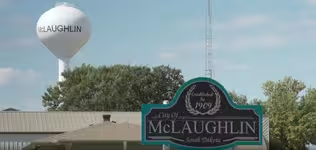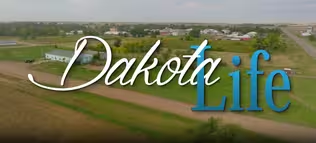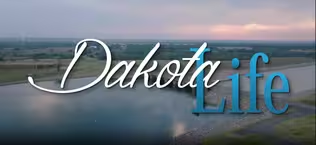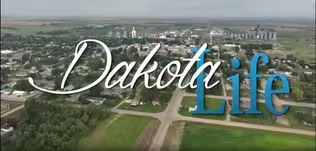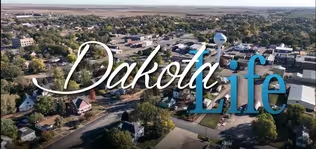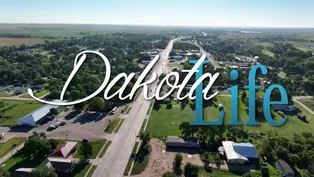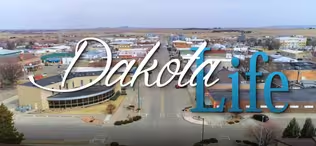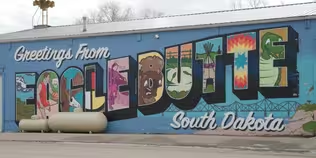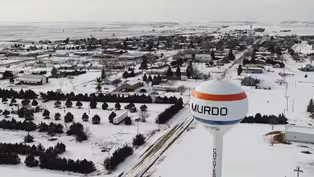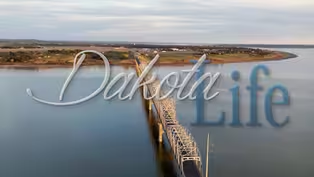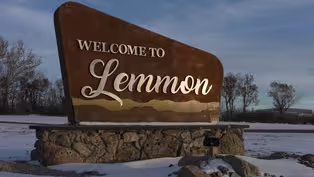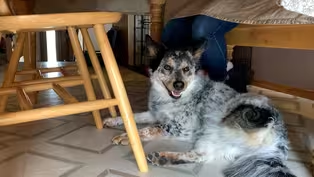Dakota Life
Greetings from Fort Pierre
Season 23 Episode 8 | 28m 36sVideo has Closed Captions
Fort Pierre is our host community this month for Dakota Life.
Chat with cowboys of Diamond A, Rosebud grows their bison herd, Photographer and Educator John Banasiak is celebrated and meet Pat Duffy a long time Fort Pierre business woman with spunk.
Problems playing video? | Closed Captioning Feedback
Problems playing video? | Closed Captioning Feedback
Dakota Life is a local public television program presented by SDPB
Support Dakota Life with a gift to the Friends of Public Broadcasting
Dakota Life
Greetings from Fort Pierre
Season 23 Episode 8 | 28m 36sVideo has Closed Captions
Chat with cowboys of Diamond A, Rosebud grows their bison herd, Photographer and Educator John Banasiak is celebrated and meet Pat Duffy a long time Fort Pierre business woman with spunk.
Problems playing video? | Closed Captioning Feedback
How to Watch Dakota Life
Dakota Life is available to stream on pbs.org and the free PBS App, available on iPhone, Apple TV, Android TV, Android smartphones, Amazon Fire TV, Amazon Fire Tablet, Roku, Samsung Smart TV, and Vizio.
Providing Support for PBS.org
Learn Moreabout PBS online sponsorshipMore from This Collection
Dakota Life stories from towns in central South Dakota
Video has Closed Captions
In the heart of the Standing Rock Indian Reservation, we discover McLaughlin. (29m 29s)
Video has Closed Captions
We travel to Burke and introduce you to a writer, an artist, and the twins of Franklin Street. (29m 50s)
Video has Closed Captions
Timber Lake celebrates its heritage in July with the Days of 1910 activities. (29m 41s)
Video has Closed Captions
Uplifting culture of the Dakota Oyate on the Crow Creek Reservation. (29m 17s)
Video has Closed Captions
Onida is home to a ranching family, a salmon fisherman, and a memorabilia collection. (27m 18s)
Video has Closed Captions
Dakota Life travels to the community of Mission. (29m 34s)
Video has Closed Captions
Winner has great baseball, theatre, and local authors and is a sportsperson's paradise. (27m 25s)
Video has Closed Captions
Dakota Life visits the community of Eagle Butte (26m 58s)
Providing Support for PBS.org
Learn Moreabout PBS online sponsorship(bright upbeat music) - [Larry] The Fort Pierre area, has long been a crossroads and a meeting place.
There's evidence that the Arikara Nation inhabited this area as early as the 1400's.
They were met by European explorers near here, in 1743.
To mark that occasion, and to claim the land for France, The Verendrye Brothers buried a lead plate on the hillside.
That marker was found by school children in 1913.
It's now in the State Cultural Heritage Center, across the river.
Welcome to Dakota Life, and greetings from Fort Pierre.
This is where the Bad River meets the Missouri.
Just North along the river, a trading post.
The Fort Pierre Chouteau, was built in 1832.
The US army purchased the property in 1855, building Fort Pierre.
The first military outpost in the upper Missouri.
The community commemorates these events and others, as history you can touch.
And coming up in our episode today, we'll also meet Pat Duffy.
She's still leaving her mark on Fort Pierre at the age of 90.
We'll travel South to Rosebud, where tribal members are expanding their bison herd.
And go down river to Vermilion, where John Banasiak has spent four decades asking students to trust their imagination, and teaching photography.
First though, "The Cowboy Heritage".
At the time, The Diamond A Ranch, was the largest in South Dakota.
Some of their former employees, gathered to reminisce about the old ranch hands they knew and worked with.
Their stories are a direct link to The Old West.
- [Brian] Bob Rose is 96 years old, and learned a thing or two about cattle, working for the Diamond A Ranch.
- I heard about these vast herds that are driven up here, from Arizona through New Mexico.
And to me, a vast herd, is more than 400 or 500.
So damn hard to control.
- [Brian] Rose is one of a shrinking number of people who used to work for the Diamond A.
They call him "Young Bob".
His father was "Old Bob".
Old Bob worked for the Diamond A for 67 years.
He was working for the outfit, even before the company established itself in South Dakota.
- [Bob] Well, my father worked, with the Diamond A in Montana, starting the 5th of July, 1912.
- [Brian] The Diamond A out of New Mexico in Colorado, started leasing South Dakota land in 1907.
In the early years, the outfit ran some 50,000 head of cattle, on 1.4 million acres of range land.
More or less centered on the town of Eagle Butte.
Despite ownership and management changes, Diamond A managed to stay afloat, through the 1950s and early 1960s.
A few of the ranches former employees, established their own farms and ranches, and still live in the area.
It seems like everyone has a story about a time when things didn't go quite as planned.
- The one time I'd read their wishes, getting ready to brand.
We had 5,600 head in that, corral.
And I think Roy Hunt was I think, the boss there.
And I seen this train coming.
I said, "Right, you know, that train honks to Hunt."
(indistinct) All he wants, he can see all of these columns here.
He will, sure as hell, he honked the horn.
Then comes later, South side of that crowd is flat as a pancake.
They run for five miles.
(murmurs) Then we'd get a saddle up, took it away.
We never did find them all.
- [Brian] Everett Hunt is from Eagle Butte, and remembers the story his dad told him.
About a time, when a guy riding a motorcycle, on a nearby road, spook the herd they were working with.
- They had gathered about 1500 head of big steers.
He said four and five-year old steers hadn't seen a man, but once or twice in their life.
And they trailed him up the land tree, and they were gonna load them on cars.
And there was a big dry lake bed.
So they bedded them and nighthawked them.
(chuckles) And, he said everything was going good and well.
And the train, they could hear the train coming in.
And, pretty soon here come a guy up over the hill, with a motorcycle.
And the way want them steer.
He said, we got them circled around, bedded down again.
Here he came again.
And dad said that Tom Scoggins rode up to me, and he said, "Jack, you stay right here.
If that son of a (beep) comes by here again, your job is to rob him."
(people laughing) - [Brian] They say the pay was fair.
The hours were sometimes long.
But you might have to work at any time of day.
- Yeah, we'd do cows all night.
It was hot.
So we waited until dark.
And cows knew they was going to the river anyway.
So we filled her down in the dark at night.
- [Brian] As for the cowboy persona.
There's a lot of joking around.
Lot of practical jokes.
And if anyone offers you a cup of Cowboy Coffee, you might consider this story.
Jim Holloway lives near Faith.
His dad was a brand inspector back in the 40's.
And Holloway remembers going to visit the Diamond A.
While his dad talked outside with old Bob Rose, his mom decided to make some coffee in the ranch house.
- Old Bob had coffee pot on the back of the store.
My mother decided to go to make coffee.
Opened it up.
It was dirty.
So she, went to throw it out, and there's a dish right in the bottom.
She throwed it out, washed the pot out, put fresh water in, and made coffee.
A little bit, a while later, Bob came in and his coffee pot was cleaned and had coffee.
He said, "You've ruined my coffee pot, she's ruined my (beep) coffee pot."
(Jim laughs) - [Andy] So, he would never throw the grounds out till the- - He'll know.
There's much groans in there for him.
(Jim chuckles) Just cook them over and over.
Make better coffee that way.
(Jim laughs) - [Brian] Bob Rose can tell you the difference between a cowpoke and a cowpuncher, and a saddle bum.
He always thought he wanted to be a saddle bum.
- A saddle bum was anybody who sat on a horse.
And, that's a battle he was good for.
(flute playing) - [Brian] Rose also has an idea about what might get a cowboy labeled "All Hat, No Cattle."
- [Bob] Some saying that they talked about girls.
That's all I wanted to do, is talk about girls, when they were out on the range.
And then when they got to town, where there was liquor, Hunt was going to the bar, and all they will do is ride bucking horses.
(Brian laughing) - [Brian] To learn more about the Diamond A Ranch, and hear more stories.
Check our website @sdpb.org/imagesofthepast.
- More of the Cowboy Culture is on display here at the Casey Tibbs Rodeo Center.
Tibbs was born about 50 miles Northwest of Fort Pierre, along The Cheyenne River.
In 1949 at the age of 19, he became the youngest man ever to win The National Saddle Bronc Riding crown.
Casey Tibbs spent his life working to improve the image of professional rodeo, and donated a lot of time to charity work.
The 4th of July, rodeo here in Fort Pierre, is one of several during the summer season.
That continues the legacy of Tibbs and all of those who came before.
But animal husbandry is also a critical skill for cattlemen.
Encouraged by his Lakota wife, Good Elk Woman, Fort Pierre rancher, Frederick Dupree, is credited for his efforts, to save the Buffalo from extinction.
They captured five Buffalo calves, and raised them on the ranch.
Growing the herd tenfold.
Those animals were purchased by James "Scotty" Philip.
The bison in Custer State Park, can be traced back to The Phillips Ranch.
They're also looking forward in Rosebud.
And, they're growing the bison herd along the way.
- [Wizipan] Our project is called "Wolakota".
And, what that means in our language, is to live the Lakota way of life.
And, so this idea that our identity, is linked from the health and welfare, and wellbeing of Buffalo.
And when they're strong, we're gonna be strong again as well.
(bright upbeat music) This is an opportunity to not dwell on the past, but to acknowledge it.
And move forward with new vision and with new light, into a future that is healthy for our people, for our region and for the planet.
The Rosebud Sioux Tribe, purchased this land and then put it into trust, and brought it back into their territory.
Under their control.
Our project will create a 28,000 acre, regenerative buffalo range, that will be home to 1500 buffalo.
Previously, and in past years, it's been a working in operational cattle ranch.
We are now in the process of converting it to what will be, the largest native American owned and managed buffalo range in the world.
Our buffalo are gonna be coming from a variety of sources.
And in particular, we're really excited about our partnership with the US Department of Interior.
Which has what they call "A ten-year National Bison Management Plan".
Which, is the plan and framework for how they manage all of their buffalo across all of their federal lands, National Park Service, and fish and wildlife animals.
- [Brendan] This bison working group, drafted for the secretary of the interior.
"The Bison Conservation Initiative" that was released in May of this year.
Part of that initiative, goes to focus on doing something that has been difficult for us to do in the past.
And that is to move beyond thinking about, species level management and genetic conservation.
And to really, actively try to link ecological restoration with cultural restoration.
And so this project today is really emblematic, of that effort to link ecology and culture.
Both within the National Park System, but beyond federal lands as well.
- Well, we're all about preservation and cultural cultural heritage.
And natural resource heritage.
And so bison sort of, fits all those categories there.
I mean, they're extraordinary national resource, through the national mammal.
But they're also very important culturally to native Americans.
And so, this project is just perfect for the mission of what the National Park Service is.
And in addition, enhancing bison conservation across the country, and at a landscape scale.
- [Wizipan] This is the first time that a non-federal entity is a part of that National Bison Management Plan.
Which means that we'll be able to receive and also exchange buffalo, with all the fish and wildlife herds, with all of the National Park herds.
The beginning and the start of this herd is coming from, The Badlands National Park in South Dakota.
And the Theodore Roosevelt Park in North Dakota.
- [Mike] Our involvement in this project at Badlands National Park, was essentially to provide 50 bison, for the establishment of this new herd at Rosebud.
And, you know, the great credit is due to our resource, outstanding resources team.
And field employees at Badlands National Park, who not only help day-to-day with managing the second largest herd of bison in the National Park System, but also on an annual or every two year basis.
Capturing bison, for distribution of surplus bison.
- [Wendy] Theodore Roosevelt National Park, also rounded up 50 bison for this donation to the Rosebud Sioux Tribe.
And we were in conversations with the Rosebud Sioux Tribe.
I believe it was the REDCO Group.
And Wizipan, was describing, how the tribe would like to have a bison herd that represented culturally the tribal makeup of people.
So, having grandfathers, grandmothers, mothers, fathers, younger people, children in that bison herd, was very important from a cultural perspective.
- [Mike] This project goes beyond just delivering bison to tribes.
This project is really oriented to achieve multiple goals.
So ecological restoration and cultural restoration for sure.
It also intends to hit marks for economic development.
Some job creation here on the reservation.
And food sovereignty for the Rosebud Nations.
- [Wizipan] This is an opportunity for us to do what we call the development and implementation of local solutions to global challenges.
And this is going to be an example, not only for other native nations.
But really for the rest of the world to look at and say, "Hey, these guys are doing something pretty cool."
Out in the middle of what we now call South Dakota.
We can do that in our area, in our territory, as well.
(soft music) - As we come back to Fort Pierre, you can stop off @sdpb.org/dakotalife.
You'll find a couple of stories there.
One, is about the sought after antler sheds.
No, that's not a building.
We follow a family that hunts for those antlers shed by animals as they grow a new set.
And, you may be adjusting for a return to the office after the pandemic.
Well, what about your canine co-worker?
They become used to having you around the home.
Fort Pierre embraces being a bedroom community.
Over 80% work across the river in Pierre.
And many come back home each day to a waterfront home.
Marian's Garden is one of three housing developments along a neighborhood canal, that's connected to the Missouri.
It provides immediate backyard access to the river.
A Marina Project is underway in the commercial district.
And behind me, the John C. Waldron Bridge, connects Fort Pierre and Pierre.
The name honors Commander Waldron.
He led a Torpedo Squadron, to locate the Japanese carrier fleet during the Battle of Midway in World War II.
Waldron was born on a ranch near the Bad River.
All of the planes in his group, were shot down during that attack.
But he was awarded the Navy Cross Posthumously.
And his bravery is celebrated here in his hometown.
Construction is underway for a new Missouri River bridge.
That's set to open in 2023.
John Banasiak is one of five honored in this year's Governor's Awards in the Arts.
They're recognized for excellence in their craft, and contributions to the culture of our state.
Banasiak is a professor in USD.
And he celebrates his award, as a collaboration of many talented people.
(soft piano music) - [John] If you're on a visual of exploration, you're out dig up something that you haven't seen before.
Or you never interacted with before.
You have to be that far open to just ask people.
Or go places where you wouldn't usually go and deal with the consequences.
Which could be good, could be bad.
But you have to have confidence in your own imagination.
I think it's a useful educational tool, to have those kind of unexpected things happen.
Even obstacles, problems you get in the way.
Those are the only opportunities.
You have to really learn something.
You know, if everything went fine, you probably didn't really learn that much.
- [Mellisa] Art has been the way that John Banasiak has communicated with his environment.
First as a child.
Making up stories about days, running around with buddies.
Then as a school boy sketching in class.
- [John] The nuns there, always would ask me to draw the posters or something.
'Cause I guess I could do it.
And I just enjoy doing.
I don't know where it came from.
One of them even said, "You know, you ought to go into art and be an artist someday."
- [Mellisa] Banasiak is indeed a very talented artist.
He spends free time making assemblage art.
Similar to the shrines, made by his Polish Catholic grandmother.
And ambling through neighborhoods, looking for striking images.
- You know, when you walk around at night, dark enough to block out any potentially distracting elements.
And so it's easier to isolate specific things.
Direction of light cashing the shadow there too.
It looks like some, background in a Salvador Dali painting.
- [Mellisa] Educated at The Art Institute of Chicago, plus the university of Krakow in Poland.
Banasiak has also earned numerous accolades.
His passion it turns out, has been teaching.
- Working with students day-to-day here, and watching them explore, excavate different layers of themselves.
Really is better than reading books for me.
(chuckles) I think that maybe I, in the end learn more than anybody else in my classes.
I hope to think that I'm still growing, in some significant way.
- [Mellisa] John has been teaching at USD for 40 years.
Many students have exposed and processed, endless rolls of film and sheets of paper.
Learning lessons that are as indelible as the images that create.
Maya Parry is an Anthropology student, who enjoys processing her own emotions through photography.
- [Maya] So a lot of the things that I make in class, have to do with my private deep emotions.
Sometimes, John and I will kind of work to try to formulate ideas about how I can use Anthropology, and photography together.
So looking at emotions as artifacts, or looking at specific pieces from my pastor's artifacts, that I can photograph and then use.
- [Mellisa] Students are just part of the group that appreciate Banasiak's contribution in the classroom.
The recipient of the 2021 Governor's Award in the Arts, for outstanding service in Arts Education.
Banasiak is quick to reflect on the honor.
- This year Governor's Award, is really hard to accept it personally.
The only way I could really think about it, is accepting it as a collective effort.
You know of the Art Department.
Everybody is so good here, to try and set up an environment, where learning can take place.
You know, get rid of all the distractions as much as I can.
Be as helpful as I could be.
Have all the chemicals mixed up.
Ready when anybody has a question, or they're struggling with some understanding of some idea or where they should go next.
- [Mellisa] Dillon Bryant has benefited from the innovation and collaboration.
That occurs in the classroom of this humble instructor.
- [Dillon] It's been lovely.
John has a really good way of just nurturing, just like creative ideas.
He's like stories and anecdotes.
They really help you connect the threads for like different ideas, like different ways of working.
- [Mellisa] John says that he's in no hurry to retire.
But when he does, his legacy and dedication to the exploration of ideas and self-growth will continue in people like Dillon.
- I want to be like John, when I grow up.
(Dillon laughs) And I would love to take what I've learned from here.
And everybody to bring that forward to my own students.
If I do go on to teach.
- [Mellisa] John Banasiak says, "That's as good of a tribute, as any award."
(upbeat guitar music) - There are many picturesque views in this area.
It's an expansive River Valley.
And where the Bad River meets the Missouri.
Lewis and Clark, met with leaders of the Teton Lakota Nation in 1804.
It's the site of the Fishers Lily Park today.
Water access is the star.
But there are many opportunities to get out in nature.
With a walk across the Bad River Pedestrian Bridge.
Or more walking, biking, and outdoor social spaces.
It's part of a community, looking towards the future, as Pat Duffy has been doing, for part of the Fort Pierre Business Community, for over 50 years.
Running the legendary Cowboy Bar, The Chateau, and building the Pat Duffy Community Center.
And the Quentin Sutley Senior Center.
She runs the meals on Wheels Program.
And serves as executive director, of the Community & Youth Involved Center.
And at 90, she's as indispensable to the community as ever.
- [Pat] Mary, This is Pat from the, Youth Center in Fort Pierre.
Is it there?
Okay, you need to tell her that, April 9th she gave me a cheque and it was for February.
And then I did not receive the cheque that you're supposed to give me for the selling things that 200 or 2,400, just about $2,500.
And you know, I can't operate this way.
We have to pay our bills every 30 days.
And I get a February cheque on April 9th.
I should have gotten both the February and March.
So I need to visit with her, because this can't go on this way.
I can't do it.
Okay.
What'd you give it?
All right.
Thank you.
Bye.
- [Michael] Pat Duffy's name, is well known around Fort Pierre.
Though, some may know her as Ms. Kitty.
Together with her late husband, Ed.
She ran the legendary Chateau Bar and Restaurant, from 1962 until 2013.
In 1980, she was instrumental in building The Pat Duffy Community Center.
Which provides programs for Fort Pierre youth.
Recently, she helped lead the effort to rebuild the complex.
With the addition of a senior center.
At 90, Duffy shows up before 6:00 am, every weekday at the Senior Center, to run the meals on Wheels Program.
She's also actively involved, as a board member at the Community Center.
Which recently received a federal grant, for its afterschool learning program.
As the sign on her desk says, "This is not her first rodeo."
Duffy learnt a few things in 50 years of running a bar and a place with rougher edges than her current office.
- [Pat] We'd have fights.
But we'd handle them ourselves.
My husband was a big man, a strong man.
And all I had to do is holla his name.
And he'd be over here, over there, taking care of the fight.
They knew better.
We didn't put up with fights.
But we also didn't call the police in to handle our fights.
They took care of outdoors, and we took care of our bar.
- I actually came here before I was old enough.
She didn't realize it, till I was old enough.
But there, on that day I thought, she was gonna snap the drink out of my hand, when my brother told her, I just turned 21.
- [Michael] Nowadays Duffy applies her business acumen to making sure people who can't get out, receive a meal.
And, however brief, some human interaction.
- [Jon] It would be a nightmare, I think.
And she does it.
Day in and day out.
I mean, and she does a good job of it.
To coordinate with all the people that are doing it.
And you know, you have people, myself I call up and say, "Hey, I'm not able to deliver today."
And she asks to find somebody that'll fill in, you know.
And she's able to do that on a moment's notice.
And so that takes a special person to be able to do that.
(phone ringing) Some people it's the only outside interaction they have with anybody.
And so, it's just important to them to be able to, to have contact with people, and just to have, just to be able to talk with somebody at least once a day.
(paper crinkles) - Yeah, the wind at the shore rocked of 33 degrees.
- Yeah I noticed, yesterday too, I think.
- You know, the neat thing about this place, and what Pat has built it into, is that you talk about things falling through the cracks.
In communities.
And this is kind of a place.
And Pat's developed it into a place where, she feels the cracks.
- [Pat] I don't really know how much longer I'll be here.
As long as I'm able, I will be.
I wouldn't even be happy siting at home.
I can see why older people forget what day it is, or what time it is, or it's not the same.
So as long as I can, I'm gonna be coming here.
Getting up and going to work.
Well, you can come in between 10 and 10:30, I said.
But, sometimes you're not ready, right at 10, you don't have to wait.
Okay.
All right.
Thank you.
Bye.
(phone ringing) - Fort Pierre is the only bicentennial community, in South Dakota.
And with folks like Pat Duffy, it reflects a strong and supportive community spirit.
History is around every corner here.
The river was the first highway system.
And, once gold was discovered in the Hills in 1874, this was the nearest river stock.
Stagecoach routes fanned out in every direction.
The Chicago Northwestern, has served the area for more than a century.
So, make sure you stop by and see the memorabilia, at the renovated Depot.
From tribal gatherings, to ranchers and settlers, to a residential and recreational area.
This community along the Missouri River will remain vibrant for another century or two.
Well, that wraps up this Season of Dakota Life.
We'll be traveling the state in the months ahead, for more stories.
And planning to visit new communities this season too.
The stories of our Fort Pierre visit, and all of the communities we visited this year, are available for you @sdpb.org/dakotalife.
Thanks for coming along with us.
I'm Larry Rohrer.
For all of us at SDPB.
Thanks for watching.
(bright upbeat music)
Video has Closed Captions
Clip: S23 Ep8 | 4m 40s | Dogs have been coworkers for many folks working from home. (4m 40s)
Video has Closed Captions
Clip: S23 Ep8 | 2m 27s | Searching antler sheds is a bigger thrill than hunting the animal for two South Dakota men (2m 27s)
Providing Support for PBS.org
Learn Moreabout PBS online sponsorshipSupport for PBS provided by:
Dakota Life is a local public television program presented by SDPB
Support Dakota Life with a gift to the Friends of Public Broadcasting
